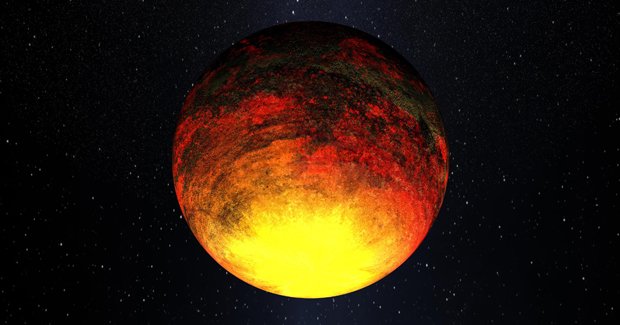NASA spots Earth-sized rocky planet

A TINY, ROCKY PLANET about the size of Earth has been discovered by NASA. The exoplanet, named Kepler-10b, was spied in a speedy orbit around a star 560 light-years from our solar system, but its scorching temperatures are too hot for life, the space agency said.
It is the smallest-ever planet – at 1.4 times the size of Earth – discovered outside our solar system, and was located by NASA’s Kepler spacecraft. It spins around its star more than once a day, an orbit much too close for life to survive.
“Kepler-10b is definitely NOT in the habitable zone as we define it,” NASA expert Natalie Batalha said in a web chat about the discovery. “The dayside temperature of the planet is expected to be higher than 1371 Celsius!! That’s hot enough to melt iron!
“It wouldn’t be a very nice place for organisms like those on Earth to live. Carbon-based chemistry wouldn’t thrive there. Molecules comprising RNA and DNA couldn’t stay intact in such extreme temperatures,” she added.
Another planet possible
The planet completes a full orbit once every 0.84 days, and is 23 times closer to its star, Kepler-10, than Mercury is to our sun. Kepler-10 is one of the brightest stars the mission is studying, making it easier to detect possible planets.
According to Douglas Hudgins, Kepler program scientist at NASA’s Washington DC headquarters, the discovery is promising even though no life could exist there.
“The discovery of Kepler 10-b is a significant milestone in the search for planets similar to our own,” he said. “Although this planet is not in the habitable zone, the exciting find showcases the kinds of discoveries made possible by the mission and the promise of many more to come.”
The new planet has a mass 4.6 times that of the Earth, and an average density of 8.8 grams per cubic centimetre, similar to an iron dumbbell, NASA reported. The findings are described in The Astrophysical Journal.
Natalie, who is a professor at San Jose State University invovled in NASA’s Kepler Mission, said there is evidence of another potential planet in the same star system, but little is yet known about it.
“There is actually already a very compelling signature of another potential planet in this system,” she said. “There is a transit event that recurs once every 45 days and is suggestive of a planet a bit larger than two times the radius of the Earth.”
Planet mission
Kepler is NASA’s first mission in search of Earth-like planets orbiting suns similar to ours. It launched in 2009, equipped with the largest camera ever sent into space – a 95-megapixel array of charge-coupled devices – and is expected to continue sending information back to Earth until at least November 2012.
The space telescope is searching for planets as small as Earth, including those orbiting stars in a warm, habitable zone where liquid water could exist on the surface of the planet. NASA defines the habitable zone, in part, to have a temperature below the boiling point of water and higher than the freezing point.
Kepler is not equipped to detect signs of life, such as the presence of oxygen in the atmosphere, but mainly aims to locate Earth-size planets outside our solar system.
RELATED STORIES

